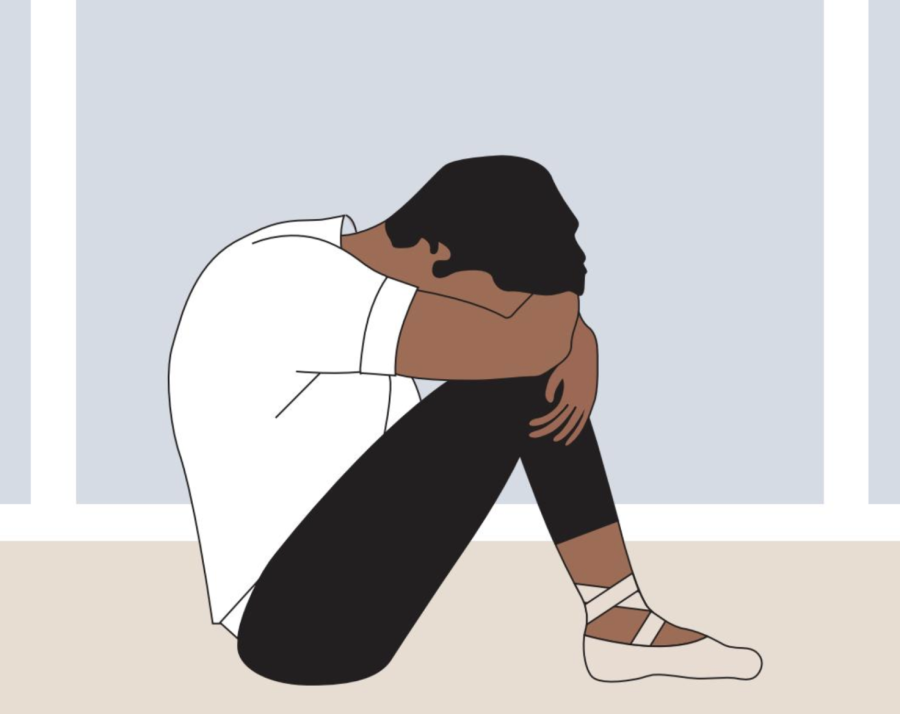Boys dance too: My experience as a male ballet dancer
The words “gay” and “girly” unsurprisingly continue to follow me, but I understand now that those juvenile claims are part of a larger pattern of people denying other men’s masculinity to assert their own.
January 22, 2023
This story was published in print in December 2022.
The faint sound of pointe shoes echoes through a narrow walkway as I begin to ascend a set of stairs. With each step, the soft tapping crescendos into a storm. At the top, I take a right, passing a wall peppered with photos of famous dancers, choreographers and directors. I turn left, passing a bulletin board of castings, rehearsal schedules and showtime updates. One more left turn to go. My mind desperately tries to calm itself down, but doubtful thoughts start to seep in. With no time left to spare and my mind shaking off the last drops of doubt, I turn to face the dance studio.
For six years, I’ve danced at Maryland Youth Ballet and earned incredible opportunities. I’ve landed lead roles in my studio’s productions, worked with world-class choreographers and even performed in a professional production at the Kennedy Center. But those opportunities didn’t fall into my lap — they required limitless dedication and sacrifice.
What started as a three-hour weekly obligation where I learned the basic positions and steps, quickly snowballed into a 25-hour weekly commitment. Two classes became three, three became four and four became five. Hour-and-a-half classes turned into two-hour classes, and hour-long rehearsals grew to four hours. Despite the grueling work, I continued to crave the feeling of soaring through the air. I loved my reflection, and I even used to think I was the next Mikhail Baryshnikov — arguably the greatest male dancer of all time who revolutionized the art of ballet. Ballet was addicting for me. Every lift, every turn, every leap fed my insatiable hunger for perfection.
I’ve realized perfection is impossible, but ballet remains just as intoxicating now as it was when I started six years ago — though as the saying goes, beauty is pain, and there is no statement more applicable to ballet than this one.
Meticulous critiques of my dancing prepared me for the increased expectations in each level of training, but no amount of time in the studio could prepare me for the supposed insults I would face. Assumptions that I was “gay” and “girly” solely for dancing became the norm. My middle school classmates would often snicker behind my back, believing ballet to be anything but masculine. I knew the comments were rooted in ignorance and childishness, as expected from middle schoolers, but the words hurt regardless.
As the comments continued, the dancefloors I once adored transformed into inescapable pits of uncertainty surrounding my masculinity. While my dancing abilities soared, my thoughts began to slip. With every leap and turn, I questioned everything. Was I “gay” for being there? Should I have stuck with a “manlier” sport? Was I less of a man for dancing? Every question I posed and every doubt I held only fueled the confusion that pained me so deeply.
Despite the comments, my dancing continued to improve. Within five years, I progressed to the pre-professional level and earned a spot in my studio’s company, dancing principal roles and performing upwards of five times per year.
The words “gay” and “girly” unsurprisingly continue to follow me, but I understand now that those juvenile claims are part of a larger pattern of people denying other men’s masculinity to assert their own.
After years of explaining to confused faces that I dance ballet, I’ve realized that a lot of people may be uncomfortable with the idea of a male in a majority-female discipline and will seize that discomfort as an opportunity to judge.
People ask if I joined ballet solely to be in a class full of girls. Others try to explain to me that I’m “just as manly” as football players and professional boxers since they dance ballet as part of their training. The occasional person will even tell me that it’s “brave” of me to dance as if I’m sacrificing my masculinity every time I step on a stage. I’m not brave, and I’m not a boxer. I’m just a ballet dancer, and that’s enough to respect my masculinity.
I’d be lying if I said there aren’t inherent benefits to being a guy in ballet. Due to the lack of male dancers, I get a lot of undeserved attention from teachers. Consequently, dancing is a less competitive sport for me than it is for my female counterparts. I statistically have a better chance of receiving a lead role than they do. That’s just a consequence of a sexist system, but the system is a two-sided coin.
Those same statistics that land me lead roles also dictate that I can’t afford to underperform. The pressure to consistently meet expectations — ones I don’t set for myself — is crushing. I’m responsible not only for my success but for the success of the girls around me, and that’s a stress I feel every time I step onto the dance floor.
But ballet, for all of its flaws, has shaped who I am — and there is nothing I am more grateful for. Nothing disciplines me like forcing myself to show up at the studio for three and a half hours on a Friday. Nothing satisfies me like the curtains closing on the last of 10 consecutive Nutcracker shows. Nothing shows me the value of the present like performing one last time with my closest friends. And nothing teaches me pain like a two-minute solo does.
In truth, I don’t think the sexism surrounding ballet will ever go away — but I can’t give up on it. No matter how many insults I hear or how intense the pressure gets, I have to push myself. I have to shoulder that weight, because despite all of the sexism, deprecation and sacrifices, the beauty of ballet will always be worth it to me.








Amy B. Cole • Jan 24, 2023 at 7:32 am
I graduated from Walt Whitman back in the mid 1970s. I loved your piece about your ballet path. Life is all about figuring out what you enjoy doing with your time on earth.
I have a son who was on the dance track. He graduated early and spent his “senior” year dancing as an intern with Charlotte Ballet. Then he spent his college years with NC School of the Arts. From there he spent a few years in NYC. Now he has taken on the challenge of being the executive director of White Bird in Portland, OR. He has to put together Seasons of 9 – 11 shows consisting of visiting Dance Companies. Check out their website.
Although he is all about the beauty and powerful messages of dance, he has to balance that with the reality of making the budget work or fundraising with grants. KEEP DOING WHAT YOU LOVE AND YOU NEVER KNOW WHERE LIFE WILL TAKE YOU.